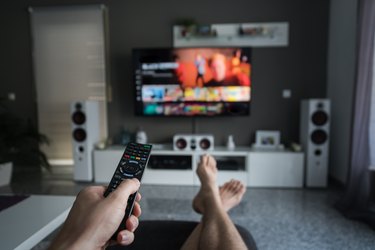
The "PC Mode Not Supported" error is the result of a miscommunication between a Samsung LCD TV and a connected computer. Essentially, the computer settings and television settings are misaligned, and the picture does not display. Adjusting the settings to match the display size often fixes the problem.
Check the Connections
Video of the Day
Before making changes to the computer and television settings, make sure the connections are correctly set up. An HDMI cable is frequently used to connect a computer to the television, but VGA cables are also effective. Each end of the cable must be snug and secure in the correct port location. This setup is common for office presentations that require a larger screen than the laptop or PC.
Video of the Day
After checking the connections, make an attempt to display the computer screen on the television screen. If the error message is triggered again, the settings require adjustments to match the resolution and sizing. If the message does not display and the television screen remains blank, try a different HDMI or VGA cable. A bad cable can interfere with the connection. As a final consideration, use a short cable, preferably under 6 feet in length, to create a more reliable connection for transferring media across the devices.
Adjust the Resolution
The most common reason for a "PC Mode Not Supported" error message is a resolution conflict. The television may have a lower maximum resolution than the computer, and it cannot display the imagery. In this scenario, you must lower the resolution on the computer to match the television's maximum resolution. Another option is to update the computer's video card to support a higher output resolution when the television is newer than the computer.
Another reason for resolution discrepancies stems from the HDMI external device settings on the television. The default setting automatically adjusts the resolution, but this does not always work properly when the TV is connected to a PC. Change the setting to a fixed resolution and experiment with different resolutions until you find one that works. Then, the error no longer displays, and the computer screen displays on the television.
Changing the specific resolution on the PC and the television can also help to resolve the error. Right-click the desktop in Windows and select Screen Resolution to access the current settings. Use the slider to adjust the resolution until it reaches 1024x768 and save the settings.
Next, access the Settings on the television and click Advanced Settings, followed by Monitor. Click the Screen Refresh Rate option, select 60 Hertz, and apply the new settings. This should align the resolution between both devices and solve the issue. Open a program on the computer, and the screen should share to the television.
Incompatible Devices
In some cases, the television and PC simply do not function together. This occurs when there is a significant age difference between the models. An old PC may not have the video card quality to function across the connection, and an old television may not have the resolution capabilities to display anything sent from a new computer.
Use a newer television when possible and try different laptops and computers when the error message occurs. If a newer laptop works while an older one fails, the problem is likely a matter of device incompatibility. Experimenting with different devices can reveal an issue relating to a PC or television that is dated and not capable of screen sharing.